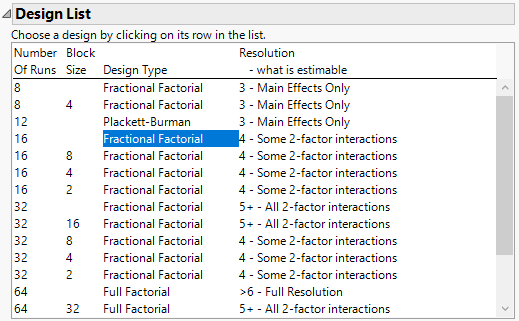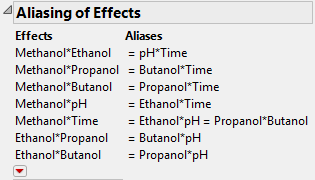Comparison with a Fractional Factorial Design
Suppose that you had chosen a traditional screening design instead of the definitive screening design in Definitive Screening Design. This example compares the two designs in terms of confounding.
1. Select DOE > Classical > Two Level Screening > Screening Design.
2. Double-click Y under Response Name and type Yield.
3. Select Help > Sample Data Library and open Design Experiment/Extraction Factors.jmp.
4. Click the red triangle next to and select Load Factors.
The factor names and ranges are added to the Factors outline.
5. Click Continue.
6. Select Choose from a list of fractional factorial designs.
7. Click Continue.
Potential designs appear in the Design List.
Figure 7.6 Screening Design List for Six Continuous Factors
8. Select the sixteen-run fractional factorial design with no blocks, shown highlighted in Figure 7.6.
9. Click Continue.
10. Open the Display and Modify Design > Aliasing of Effects outline.
Figure 7.7 Aliasing of Effects for Fractional Factorial Design
The Aliasing of Effects outline for the 16-run fractional factorial design shows that every two-factor interaction is confounded with at least one other two-factor interaction. In this fractional factorial design, the Ethanol*Time interaction is confounded with Methanol*pH. To determine which interaction is active, you need to run additional trials. If the factors had been entered in a different order, the Ethanol*Time interaction might have been aliased with two other two-factor interactions.
In the section Definitive Screening Design, you constructed a 17-run definitive screening design. The Color Map on Correlations for this DSD (Figure 7.4) shows that no two-factor interactions are confounded with any other two-factor interactions. For the fractional factorial design, there are seven instances of confounded two-factor interactions. If you suspect that there are active two-factor effects, the DSD is the better choice.
You can conduct a more thorough comparison of the two designs using the Compare Designs platform (DOE > Design Diagnostics > Compare Designs). See Compare Designs.

